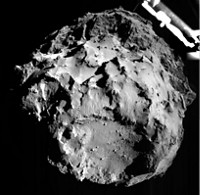Advertisement
Grab your lab coat. Let's get started
Welcome!
Welcome!
Create an account below to get 6 C&EN articles per month, receive newsletters and more - all free.
It seems this is your first time logging in online. Please enter the following information to continue.
As an ACS member you automatically get access to this site. All we need is few more details to create your reading experience.
Not you? Sign in with a different account.
Not you? Sign in with a different account.
ERROR 1
ERROR 1
ERROR 2
ERROR 2
ERROR 2
ERROR 2
ERROR 2
Password and Confirm password must match.
If you have an ACS member number, please enter it here so we can link this account to your membership. (optional)
ERROR 2
ACS values your privacy. By submitting your information, you are gaining access to C&EN and subscribing to our weekly newsletter. We use the information you provide to make your reading experience better, and we will never sell your data to third party members.
Physical Chemistry
Philae Probe Sniffs Out Comet's Chemistry
Astroscience: Researchers analyze the dust and vapor on comet 67P/Churyumov-Gerasimenko and find it contains organic molecules never-before-detected on a comet
by Sarah Everts
July 30, 2015
| A version of this story appeared in
Volume 93, Issue 31

Last November, the world watched with bated breath as the European Space Agency’s Rosetta mission landed a probe for the first time on the surface of a comet. Now a series of seven papers in the journal Science provide new data and analyses from that mission to the 2.7-mile-long, dumbbell-shaped comet 67P/Churyumov-Gerasimenko, often abbreviated as 67P.
Among the results of imaging, radar, and other experiments, two papers reveal the molecular makeup of 67P, including the observation of four organic molecules not previously observed on a comet and the presence of a radiation-induced polymer (Science 2015, DOI: 10.1126/science.aab0673 and 10.1126/science.aab0689).
The washing machine-sized Philae probe had a rough landing. On its first touchdown, the systems required to tether the probe to the comet’s icy, solid core failed. So instead, Philae bounced several times, colliding with the rim of a crater before coming to its final landing spot more than a kilometer away, says mission scientist Jens Biele at the German Aerospace Center in Cologne, Germany.
Because of these landing glitches, several of the mission’s scientific operations failed, including a plan to drill into the comet’s interior and send the samples to two mass spectrometers on the lander, Ptolemy and COSAC.
Luckily, however, both mass spectrometers have an emergency “sniff” mode, says Fred Goesmann, who leads the COSAC experiment. This permits the analysis of molecules that have passively percolated into the apparatus through venting pipes.
Using this sniff mode, COSAC detected 16 organic compounds, including four that have never before been observed on a comet: methyl isocyanate, acetone, propanal, and acetamide. The findings reinforce the view that comets boast a rich inventory of organic molecules, comments Steve Charnley, a molecular astrophysicist at NASA who wasn’t involved in the work. It also furthers the origin-of-life theory that comets striking Earth during the prebiotic era may have supplied organic molecules that helped life evolve on our planet, he says.
Data acquired using the second mass spectrometer, Ptolemy, revealed that the comet contains organic polymers, most likely from the radiation-induced polymerization of formaldehyde, says Ian P. Wright, who leads the Ptolemy experiment. Ptolemy also detected a significant amount of carbon dioxide, a molecule that was not observed using COSAC.
This and other inconsistencies in what the two spectrometers measured—for example, COSAC found a high abundance of nitrogen-containing compounds, while Ptolemy detected none—likely “says something about the heterogeneity of the comet,” Wright says. Or the inconsistencies could have to do with the 180° difference in relative orientations of the mass spectrometers, Goesmann says. COSAC, which faced the comet surface, might have measured comet dust billowing up, while Ptolemy, which faced outward, might have measured elements of the haze around the comet’s surface.
In the meantime, Wright says the Philae mission team is busy trying to solve communication problems with the probe—the radio signal is fickle—so that they can upload new command sequences that would permit the probe to learn more about 67P.
“The results already in hand are an incredible achievement, especially considering the landing challenges and the fact that these analyses come from only about two minutes of data acquisition,” comments Michael Mumma, the director of the Goddard Center for Astrobiology, at NASA. “This work shows the very tip of the cornucopia of rewards that will ensue if they can get the damn thing working again.”
This article has been translated into Spanish by Divulgame.org and can be found here.






Join the conversation
Contact the reporter
Submit a Letter to the Editor for publication
Engage with us on Twitter